| |
|
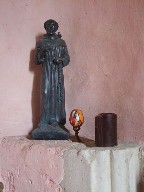 |
|
I cannot convey to you quite
how much I had been looking forward to
coming back to Mickfield church. I cycled
up the hill from Stonham Aspal, the
fields around beginning to get their
shimmer of winter barley, and then
suddenly there it was, the bulky tower
rising above the village rooftops. The St
Andrew's flag flying from the top is
incongruous at first, slightly shocking
even, especially if you have visited
several churches proudly displaying the
flag of St George on your way here. It's
a bit like seeing a single boat
displaying the skull and crossbones among
a flotilla of others displaying the red
ensign. If you did not know about
Mickfield church, you might wonder about
it. Coming closer, your wonder might
increase: a large sign by the roadside
tells you that the church is open, and
that you are welcome. A driveway takes
you down to the west end of the nave, and
parts of the graveyard are neatly marked
off with domestic fencing; the graveyard
behind has been turned into a garden.
Everything is neat and tidy, and lovingly
cared for. It is as if it is a church in
a dream. I opened up the
north door, and stepped inside. I had
entered a kind of a hallway, with doors
off in several directions. A large sign
on the noticeboard declared We are
sorry that there is no-one here to
welcome you. Please do look around the
church: there are guide books and
Heritage Trail leaflets on your left.
Please help yourself to some refreshment
in the kitchen if you wish. The
kitchen turned out to be straight ahead,
the conversion of the south porch. I
stepped through.
|
Here was
another sign: We are sorry if there is no-one
here to offer you hospitality. Do help yourself
to a cup of tea or coffee or a soft drink and
biscuits. There followed a long list of
instructions on where to find everything, which
concluded Every blessing on your onward
journey! Come again soon!
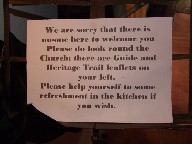 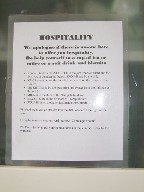
This filled me with an intense
delight. I want to tell you about this
extraordinary place, but first I must recall my
first visit to Mickfield, almost exactly ten
years before. How different things were then. At
the time, I had only recently started trying to
visit all of Suffolk's medieval churches, and I
had no idea of what to expect here at Mickfield.
I had seen the church marked on the map, and I
had read brief accounts of it in Pevsner, Cautley
and Arthur Mee. As I came closer, I was shocked
to see the broken tracery in the tower windows,
the ivy and elder creeping up the masonry.
I pushed my bike along an overgrown
track, avoiding brambles, rusting cans and other
litter. Two gravestones, to a father and son of
the Lucock family who died within a few weeks of
each other, stood sentinel at the entrance to the
churchyard proper. This was overgrown with
brambles and nettles, but punctuated by pathways,
presumably made by local children. The confusion
boiled around what I could now see was a
completely derelict church.
| Although it had been boarded
up, some of the boards had been broken
down by vandals wanting to get inside.
Back in December 1998 it was possible to
pick your way through the broken glass,
and poke a torch through the hole in the
former north door. Inside, nothing
remained. The building had been
completely stripped of everything - floor
tiles, wood panelling, pipes, wiring. All
that was left was a stone shell, with an
earth floor. The remains of fires were
scattered around. It was a vision of
desolation. Rubble littered the floor
from the tower, now unsafe. It was
terrifying. I
took some photographs, and, chastened, I
hauled my bike back to the road and set
off westwards, rather faster than I had
arrived. Looking back from the Mendlesham
road, the tower appeared unstable, as
though groaning under years of neglect.
The photographs I took that day, and on a
day in February 2003, are to the right
and immediately below.
|
|
 |
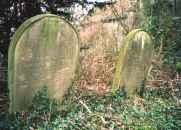 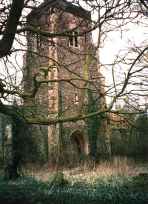  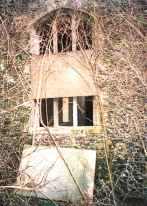
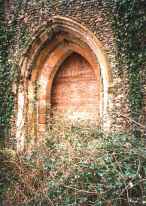 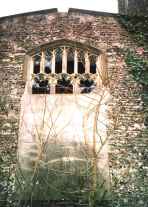 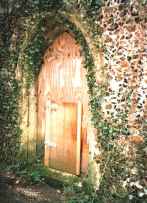 
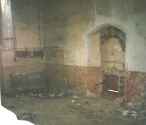 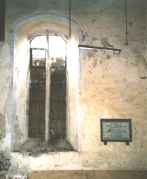 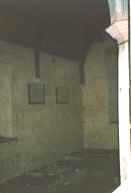 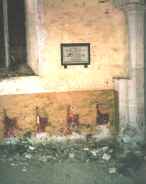 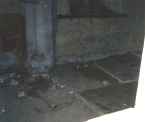
What
had happened here? St Andrew, Mickfield, was one
of the churches sold off for private use in the
1970s, as part of the Anglican Diocese's
ill-conceived plan to rationalise its resources.
Mickfield is a sizeable village, and the nearest
other churches are a couple of miles off, but the
main reason seems to have been a hefty repair
bill for fixing the unsafe tower. When it was
made redundant, the Friends of Friendless
Churches offered to take it on. It was a
significant building. It had a number of
excellent 15th century bench ends, a painted
font, a 17th century communion table, brasses of
Peter and Thomasine Preston, who died in the
early 17th century, brass inscriptions to their
son and to his contemporary Francis Dade, and a
piscina and windowsill sedilia in the chancel.
Incredibly, the Anglican Diocese
insisted that the charity pay the market rate for
it. Obviously, as a donation-funded body they
were unable to do this - and, in any case, as a
point of principle it would have been suicidal to
do so, opening the way for other greedy Dioceses
to take financial advantage of public concern for
historic buildings. A furious row ensued. As the
church stood locked and decaying, the Redundant
Churches Fund became another possible caretaker.
Instead, St Andrew was bought by an architect,
Tony Rigg, apparently with the intention of
converting it into flats. Some of the more
valuable furnishings were moved to places of
greater safety or sold off. The bell from the
tower was removed, and rehung at the pretty
church of Boulge.
It is worth saying that this
probably would not happen today. We live in more
enlightened times, and the local Diocese, as with
most, has a commitment to keeping village
churches going, by grouping them into benefices
and giving more authority to local people to
manage them. But in 1977, Mickfield church was
effectively dispensed with, and so St Andrew
waited for its fate, to become just another
house, and Mickfield to become a village without
a parish church. Other churches in the Diocese
went off to the same destiny - Ubbeston, Shipmeadow, Rishangles and Debach among
them.
But
then things started to go wrong. Mr Rigg did not
begin work here. During the boom/bust years of
the 1980s, he seems to have placed his priorities
elsewhere. From Jerusalem where he now lived, he
made it clear that he had no plans to do anything
with the shell of St Andrew. He even offered to
sell it back to the Diocese, at what appeared to
be a laughably inflated price, although this was
supposedly to cover expenses. The whole thing was
a farce of monstrous proportions. It would have
made great material for a 19th century novel, a
piquant combination of absurdity and despair.
I
came back four years later. Little had changed.
In the village itself, people were doing up their
houses, washing their cars, digging their
gardens. Children were playing around the remains
of a snowman on the village playing field,
seemingly oblivious to the bramble-surrounded
hulking tower above them. But my heart sunk as I
again walked up that track. The walls were even
more overgrown, and more glass had been broken.
There had apparently been a fire inside at the
west end; the lead in the west window was
shattered and contorted above the boarding. It
was all very depressing. But in fact, even at
that moment, plans were being laid to rescue this
great building. Local authorities have powers to
insist that essential repairs are carried out to
buildings perceived to be 'at risk', and in
extremis even to make those repairs and then
demand payment. There is even a further step
which they can take, and this is what happened.
In December 1999, Mid-Suffolk District Council
prepared a compulsory purchase order on this
building. This didn't mean that they were going
to buy it themselves - there is no way that, ten
years ago, a local authority could have afforded
the repair bill. But it would make it easier if
an eventual purchaser came along, perhaps someone
moving out of London with a lot of money to spend
on converting a place in the country. The East
Anglian Daily Times, reporting this event, noted
that the local authority had sealed up the
building up to stop children getting in and
causing damage - damage to what,
one wondered.
Despite
its south tower and coloured font, St Andrew was
never a beautiful church, being stark and grand
rather than pretty. But its dereliction made
Mickfield a village without a heart. In 1977,
when the church was closed, the parish was
subsumed into that of Stonham Aspal, to the
south. In this part of Suffolk, villages are
surprisingly far apart, and the desolation of St
Andrew was a grievous one. Seen from the fields
on the Mendlesham road, it was a frightening
place. In winter, the skeletal trees that
separate the graveyard from the cold ploughed
fields resounded to the clatter and cawing of
black crows busying themselves in their miserable
way.
In
2002, I was contacted by someone who claimed to
be part of a consortium planning to buy St Andrew
and restore it for Christian use as a prayer
centre. This was wonderful news, if a little
unlikely. To restore St Andrew to its former
state would cost many hundreds of thousands of
pounds. There seemed to be no future for this
building. I observed on this site then that
perhaps it was just as well that this sad
building should be allowed to gradually decay and
collapse. It would be a reminder of the dangers
of complacency and short-sighted cost-management.
It would serve as a reminder to the Diocese that
they have a responsibility to conserve for the
future as well as to live in the present. That
what we inherit, we do so in trust for
generations yet to come. In former times, a
disused church would never have been sold off for
profit. Instead, the roof would be removed, and
as the years passed the building would quietly
return to nature. It was ironic then, I observed
in 2003, that this seemed to be happening of its
own accord at Mickfield.
And then, things began to
happen very quickly. Ownership of the building
was conveyed to the Suffolk Architectural
Heritage Trust, which had been set up in 1997 by
members of the Suffolk Preservation Society,
itself the county branch of the Campaign to
Protect Rural England. Its remit was to follow up
buildings on the County Council's Buildings at
Risk register, take them on, prepare them for a
new use, and then convey the building on to new
owners. The new use would be selected
specifically to ensure that the county's building
heritage was maintained. The repairs were carried out with
grant aid from English Heritage and also with the
help of the Architectural Heritage Fund. While
conversion to residential use was not excluded
from SAHT's options, that was not to be the case
here. Instead, in 2004, ownership was transferred
to the Anglia Church Trust (come on, keep up),
who reopened the building as 'a Christian centre
with training and conference facilities'. That
phrase has all the hallmarks of one prepared for
a grant application, but in any case St Andrew
has turned out to be rather more than this.
And
so it was, in February 2009, that I stepped into
that north doorway, and saw the welcoming notice.
I was standing in a
passageway which runs north to south across the
church, connecting the north doorway with the
south porch. Off to the right is an office, a
stairway and a lavatory. The roof is low, because
the stairway leads to a gallery which takes up
about half of the former nave. And, through a
doorway on the left, you step into the church.
My first impression was of
fresh, pastel-coloured light. The body of the
nave is separated from the chancel by curtains,
and the pink walls and carpeted floor are serene
and gentle. It took me a moment to realise
exactly why it felt so restful, until I noticed
the grandfather clock, solemnly ticking in the
south-east corner. The chairs are arranged in a
circle, presumably for seminars and other group
activities. Somewhat surreally, two large
noticeboards on the day of my visit were headed Miracles
and The Fall, presumably neither of them
refering to the soul and punk bands of those
names. Even more surreally, the south-west corner
of the nave is taken up with a table, laid for
breakfast and with a wide dresser behind it. The
balcony extends beyond the doorway, and there is
a sense of moving into a wide open space. A
memorial from the church's previous life survives
on the north wall, along with a plaque marking
the reopening.
I stepped through the
curtains into a space which took my breath away.
It is simply one of the most beautiful chancel
interiors in all East Anglia. It felt a privilege
to be here on this beautiful sunny day. Most of
the fittings have come, ironically enough, from
other redundant churches, mostly in the
Chelmsford Diocese, but the two 14th Century pews
with their intriguing bench end carvings came
from this church originally, They were sold off
at the time of redundancy, but have been returned
to the church. They were bought for Mickfield
from a Norwich antiques dealer by the Cottam
Trust, itself an arm of the Friends of Friendless
Churches, which gives the story a pleasing
symmetry.
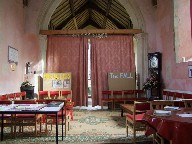
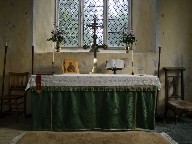 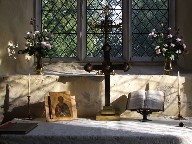 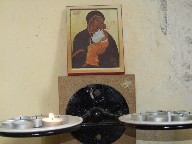
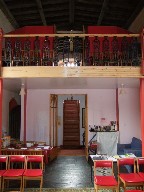 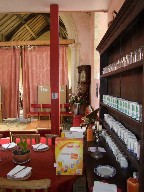 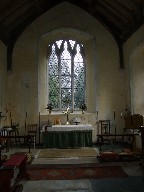 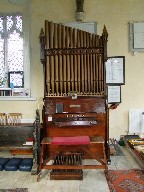 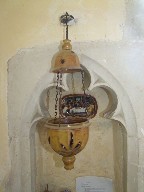 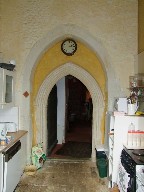
It should be noted
that the centre has no connection with the local
Anglican Diocese, although the worship and
liturgy appears to be broadly traditionalist
Anglican in style, with the use of incense and
the Book of Common Prayer. In this we may detect
the influence of neighbouring Mendlesham,
Suffolk's last thorough-going traditional
Anglo-catholic parish church. An ikon of St
Andrew sits on the altar, not something you'd
find in many Anglican churches, nor many Catholic
churches either. Mickfield chancel is host to two
acts of public worship every day of the week -
again, that's not something you come across very
often.
I finally managed
to drag myself away from the chancel, and
wandered back up to the west end, and up the
stairs. This brings you up into the mezzanine, so
large that it is difficult for a moment to
remember you are poised above the western half of
a nave. Two 14th Century roof corbels are close
enough to touch. The mezzanine has been furnished
as a kind of lounge area, I can think of no
better word, with sofas and coffee tables. One of
the tables was set for afternoon tea, with cups,
saucers, a teapot and even a plate of biscuits.
And yet all the time I was in the church, and I
was in there for more than half an hour, I did
not see or hear another soul. It really was like
being in a dream. I wandered out through the
kitchen, and into the graveyard, now a
contemplative garden. Above me, the great tower,
at last reprieved of its former misery, stood
proudly in the afternoon sun. Incredibly, it has
been converted into dormitories.
I
wandered back into the church, and through into
the chancel again. If Mickfield church had not
been abandoned, had not been nearly lost to us,
had not been rescued and resurrected, how
different things would be today! As Eliot reminds
us, What might have
been is an abstraction remaining a perpetual
possibility only in a world of speculation. What
might have been and what has been point to one
end, which is always present. Footfalls echo in
the memory down the passage which we did not take
towards the door we never opened into the
rose-garden. No, this has been Mickfield's
destiny, that it would end up one of the most
special places for any pilgrim or stranger to
visit on their journey through the churches of
Suffolk.
I
spent some time just sitting here in the chancel
reflecting. I often do this in churches, as I
know many people do, but some churches enchant me
more than others, and the sense of eternity with
which they fill me is always a good place to let
my mind wander. I sat, haunted, thinking of who I
had been and what I had been doing when this
church was abandoned, and of all the things that
have happened since. I imagined this building, a
patient, abandoned wreck, sitting here as the
seasons turned. I thought of what it might have
been like on the day that I had got married some
twelve miles away from here - it had been the
hottest day of the 20th Century. I thought of the
births of my children, and other events, sad and
happy, private and public, during the long years
during which Mickfield church had been left
abandoned. And then, that night, I had a dream. I
dreamt of a girl I had known almost thirty years
ago. I had only known her briefly, and we had
spent an afternoon walking around the cold hills
west of Sheffield, talking. That was the only
occasion on which I remember spending any serious
amount of time with her, but here in my dream I
saw her perfectly, exactly as she had been, to
the last detail. I knew that I had not been happy
when I had been with her, and somehow I wanted to
reassure her that I had been happy since, that
the last thirty years had not been unhappy like
that afternoon.
| In my dream, I awoke, and
went downstairs, but the house had
changed: it was no longer my house. The
rooms were different, the furnishings
unfamiliar - but not so
unfamiliar, not so much that I did not
feel at home. I needed to contact her and
let her know that everything was all
right, but I could not work out how to
find her e-mail address. The
consciousness of the passing of time, of
those long thirty years, oppressed me,
like any perspective opened up down our
lives. Thirty years - it's a
long time. Around me in the room, the
flowers were wilting, and pictures had
fallen from the wall. Piles of books and
records were covered in dust. I knelt and
found a record I knew I'd played her
once, and as I stood again, she was there,
sitting on the couch, and I knew then
that everything was all right.
And then I woke up. And
as I lay there, I thought of her, but I
knew that the dream had really been about
Mickfield. I thought back to the day
before, and I thought of all the people
who had known St Andrew over the
centuries as the centre of their
community, and as the place where their
families had celebrated the mysteries of
birth, love and death. I thought then of
someone leaving Mickfield in the 1970s,
and coming back today to find it as it is
now, without knowing what had happened in
between. I thought of people living in
Mickfield during the second half of the
20th Century, born here and never moving,
watching the slow, obscene degredation of
their one constant touchstone down the
long generations. It would make you want
to weep. And at last I thought of St
Andrew today, renewed, risen; like
Lazarus, back from the dead.
|
|
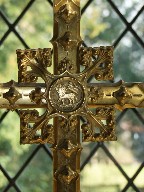 |
|
|
|

